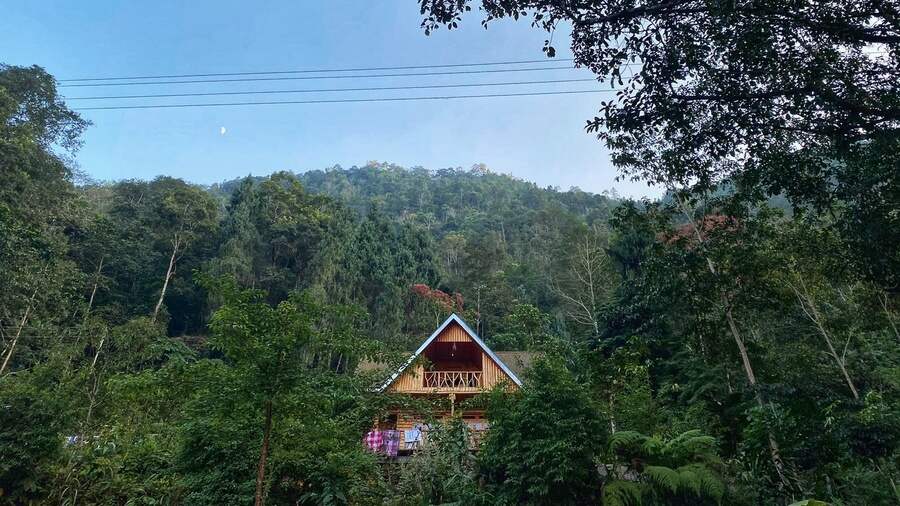The early-winter morning in the sleepy hamlet of Kharka in Bengal’s Kalimpong district greeted us with a cold breeze, sunshine on my shoulders, and the promise of magnificent views of Kanchenjunga. This lesser-known destination is perfect for a tranquil and leisurely mountain retreat.
Wonders along mountain roads
Along the route from nearest railway station New Jalpaiguri (NJP) to Kharka (or Kharka Gaon), a necessary pit stop is at Teesta Bridge near the Melli Bazaar (called Melli on the Sikkimese side) for the views and to fuel up for the journey ahead. The clear blue sky, pristine waters of the Teesta or Rangpo river, and views of green hills are just a glimpse of the gifts to be unveiled ahead.
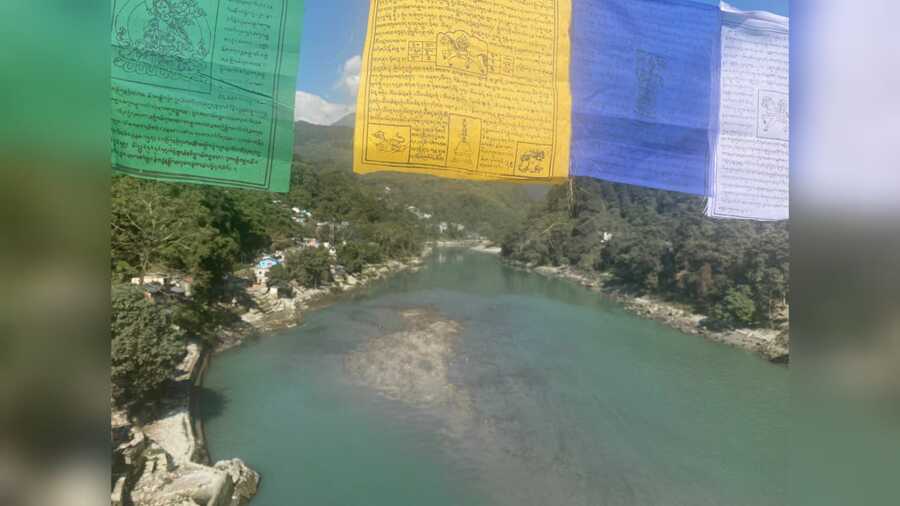
A must-stop along the route from New Jalpaiguri to Kharka is the Teesta bridge at Melli Bazaar for the views Pooja Mitra
The serpentine mountain road to Kharka passes through a forest of pine, birch, and montane flora. Rolling down the window to feel the peek-a-boo sun on my face fills the car with the fragrance of mist-kissed leaves and damp earth brought in by the cold wind. It’s the unique, yet identifiable scent of the mountain.
Wooden rest retreats — little benches under a shade — dot the path ahead, where one can soak in the view and experience nature. Sometimes, in the company of visiting birds and butterflies.

An unassuming road veers to the right leading to Kharka and only a wooden signboard behind the Golden Pine homestay indicates the route Pooja Mitra
A fork on the road welcomes you to Kharka with a wooden signboard pointing right and the facade of one of the few homestays in the village. The road, which eventually becomes the main mountain path through the village, has quaint homes on both sides. In fact, the entire walkable village of Kharka is defined by this scene. Welcoming locals are always happy to chat about the village, their everyday lives and especially their flourishing home gardens that grow squash, radish, mustard greens, and flowers.
The simple charms of Kharka

Long walks along tree-lined trails, views of misty mountains and the freshest produce — simple pleasures define a trip to Kharka Pooja Mitra
Kharka is nestled between forests of pines, oaks and sal. Orange orchards bloom here between the months of November and January, and one can often spot a barking deer or two along the walking trails. The best time to visit is from October to November, and then from March to June. According to the locals, the summers in Kharka are relatively drier compared to the damp winters.
The name Kharka, as a local helpfully informs us, means “a place where cattle graze” in Nepali, which is the predominant language among the approximately 1,500 inhabitants. Hindi is widely spoken too and Bengali often understood as well.
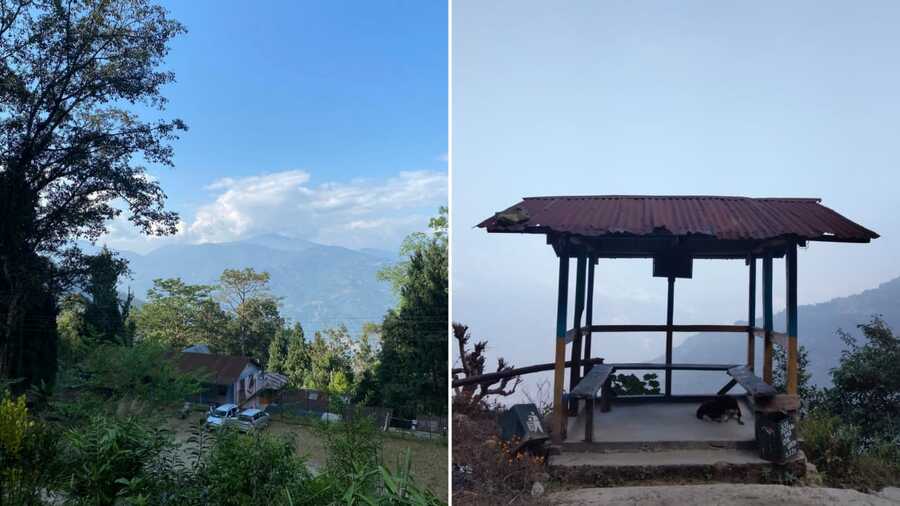
The sleepy hamlet is best explored on foot and little rest stops at view points make for a great spot to soak in the views, maybe with a cup of chai Pooja Mitra
The best part about staying in Kharka is the leisurely exploration on foot. The rocky path towards the viewpoint is hemmed by the verdant mountainside on one hand and views of the valley on the other, and fallen leaves line the way like some kind of artwork. The more defined road that veers off towards the heart of the village is lined with quaint homes and shops. A uniting feature along both journeys are the smiling faces, winter blooms, and views of the Kanchenjunga gleaming in the distance (if the weather is clear).
Itinerary for a short leisurely getaway

Weather and cloud gods willing, there are splendid views of Kanchenjunga and the valley Pooja Mitra
We reached Kharka just in time for lunch. A quick lunch later, the explorations began with a walk to the view point in the hopes of catching a mountain sunset. Winter days in the east of India are short, even more so in the mountains, and dusk settled in by the time we’d made our way up the solitary path from the homestay to the view point.
However, momos and tea kept us company back at the homestay as we watched the night sky from our verandah as it unfolded to reveal the view of a twinkling valley accompanied by birdsong.
The hopes of watching Kanchenjunga shine under the rising sun the next day were dampened by a morning covered in fog. However, the view point had a surprise — shifting clouds that flowed between the peaks like a mountain river.
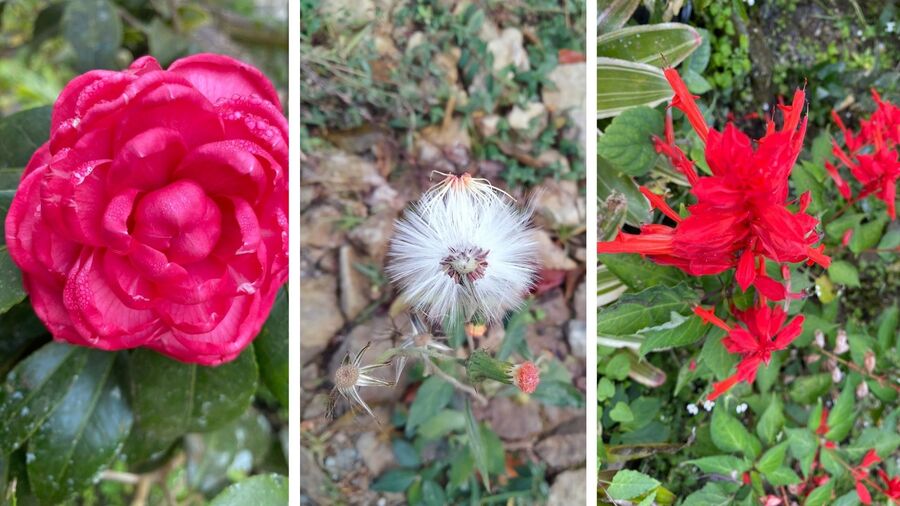
Along the walks through the village, wild and nurtured blooms welcome you every few steps Pooja Mitra
The day was spent exploring Kharka’s many charms on foot. Walking through orange orchards full of fruit-laden trees and a nearby greenhouse with a beautiful collection of orchids. There is only one route that takes you up and down the tiny village. It changes from a main road into the village to a rocky mountain trail bordered by vegetation. There’s almost always someone local to keep you company as you hike up and down the path breathing in the crisp air.
Sitting around a bonfire with warm drinks, great music (Denver and Dylan were our choices), and watching the clear sky unravel stars that shine bright is the best way to end the day at Kharka. We also had the company of many little furry canines that only added to the experiences of the day.

Kharka valley and the stream of clouds on a misty morning Pooja Mitra
Mountain souvenirs in snapshots
Mountain views may depend on the weather gods but when you do get lucky, the sights are gorgeous. Drawing the curtains open to reveal a snow-topped Kanchenjunga is a view that leaves one speechless, and our day to lose words was the third and last morning of our trip.
The rushed morning jaunt to the viewpoint was rewarded with a panoramic view of the eastern Himalayan valley crowned by the “Five Treasures of Snow” and the clicking cameras didn’t stop for a long time. The picture from the morning stayed with us as we strolled through the hamlet, eating our way to another bonfire-lit night, this time also accompanied by soft Nepali melodies that played from the homestay’s kitchen.
What’s on a plate in Kharka
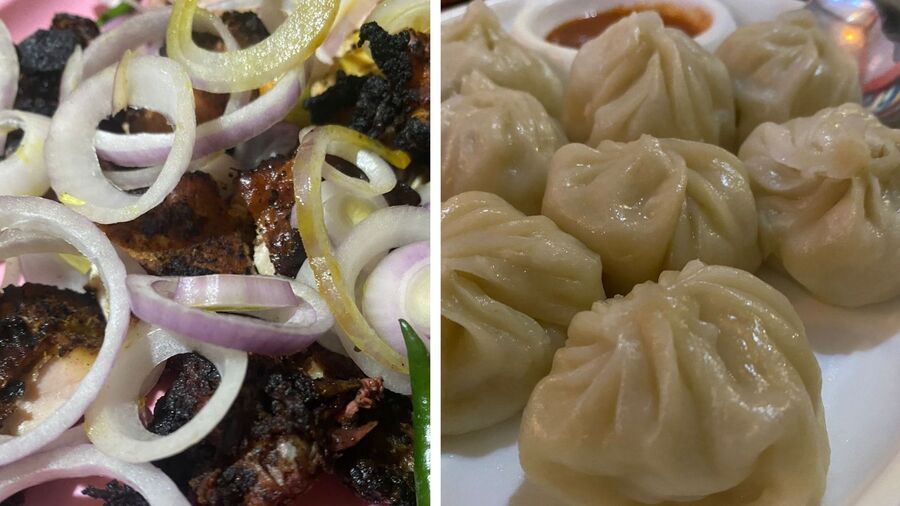
The fare at the homestays usually feature great eastern mountain staples such as momos, and succulent pork and beef dishes Pooja Mitra
Squash curries, tangy-sweet oranges that often replace lemons on the plate, succulent beef and pork dishes, mustard greens, and the local dal — all these featured in our daily meals at the homestay. Accompanying the fare were Daley Khursani chillies, that are grown in North Bengal and Sikkim, fresh and made into a spicy-lemony sauce. The small local tea shops might sometimes sell momos, but there are no eateries in the small village and most meals are had at the homestay. The menu at the stay usually features some of the best mountain-trip staples including chicken and pork momos, noodles and phaley.
Apart from the spicy chilli, Kharka is also known for its cultivation of Shiitake mushrooms, which are grown in several local greenhouses. While the expensive ingredient is not a regular feature of the homestay fare, you should definitely bring some back for your own kitchen.
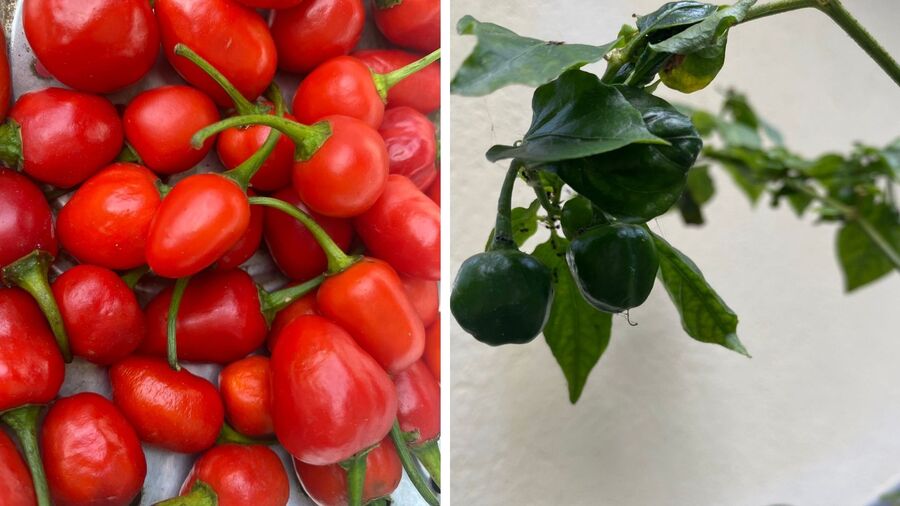
Chillies feature regularly in the food at Kharka, especially the Daley Khursani (left), which grows in North Bengal and Sikkim Pooja Mitra
Don’t forget to try the local homemade wine that comes in flavours of guras (rhododendron), guava and grapes. Chang and local distilled rum, Laksi, can also be on the tasting list when unwiding by the bonfire after a day of exploration.
Nearby places to visit
Apart from taking in the sights from the view point, there are few other things to do in and around Khirai. A short three-kilometre trek will take you to the Manedara view point near the Panchami falls.
Kalimpong is an hour’s drive from Kharka, and you can visit Delo, Durpin Dara Monastery, Durga Mandir, Buddha Park, and the Pine View Nursery on the way. The other road from Kharka takes one to Lava and Lolegaon, about three hours away. You can also visit Rishop, Sillery Gaon, and the Ichche Forests on this route.

Darjeeling is a four-hour drive away Pooja Mitra
A trip to Lamahatta and Darjeeling can be on the cards with Darjeeling being a four-hour drive away, and so can a visit to Sikkim, with Gangtok being about three hours by road.
- Travel: Kharka is about a four-hour drive from the New Jalpaiguri (NJP) station, and five hours from the Bagdogra airport.
- Stay: There are only a handful of homestays in the village. Golden Pine and Orchid are good options.

There are only a handful of homestays at Kharka and the only kind of accommodation available in the hamlet Pooja Mitra
